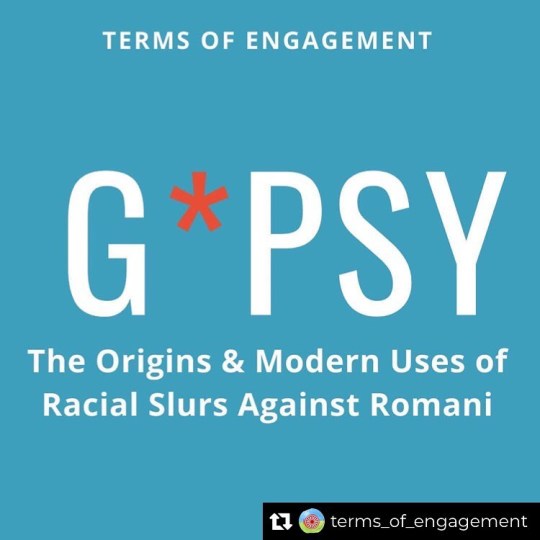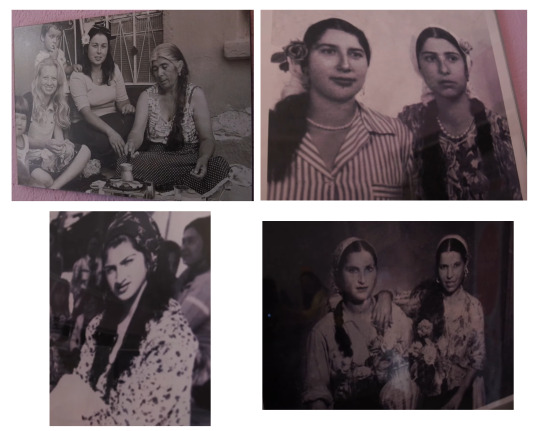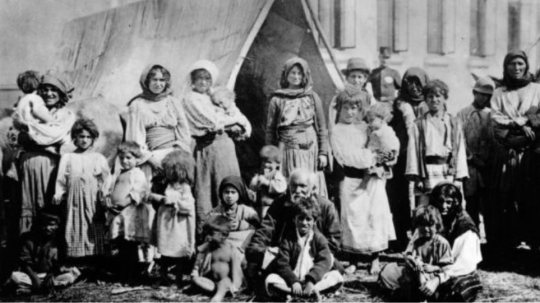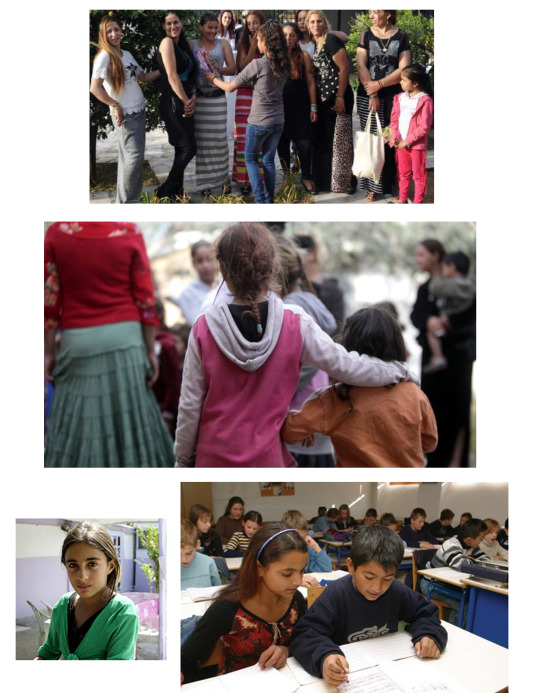#tsigani
Note
Kindly asking that you refrain from reblogging information about Roma, and what may constitute a slur against Roma, when you are not part of the community nor do you have the connections or understanding to know what constitutes a slur against Roma.
It's spreading misinformation, and it's honestly downright disrespectful.
Thanks.
Kindly asking ALL THE PEOPLE IN THE WORLD to stop reblogging about Jews if you are not one, as it is spreading misinformation and "it's honestly downright disrespectful".
Anon. That's absolutely USELESS of you.
If you find something I reblogged offensive or what have you - comment on it, reblog on it. Take a stand.
A passive aggressive anon ask is USELESS.
Are YOU Roma? Are you one of my followers/mutuals? I can never know. I can't trust you at all, I can't say if you are writing in good faith, or on behalf of a trend/common mis/conception, or if you are coming from a genuine place.
Anon, where are you from in the world? Would "Tsigani" be a slur to you or only against people in Moldova, Romania etc? Have you asked THEM if they see those terms as slurs?
Would "Soanii" be offensive? Because this is the term in Israel and other parts of the Middle East Roma are called (while "Gypsy" refers to probably Egypt, Soanii refers to Saana in Yemen or Tsoan - ancinet Egyptian city, or is a word that is reminiscent of an ancient word for "nomad".)
I will not stand for this culture of being offended by anything and everything just for the sake of it. Unless you all are ready to call all Jews "Bney / Bnot Israel" (sons and daughters of Israel). As it is not something that is plausible, Jews is OURS now. Jew derived from Yehuda, the second kingdom after the kingdom of Israel had split.
On the yellow stars in the 30-40s it was written: Jud.
In Russia and Ukraine etc we were Yevrey (which is ironically more correct on an ethnic level, and I have a suspicion as to why). If they were offensive on purpose they would use "zzid", a construct somewhere between Yid and the Russian word for "greedy" (Comunists hating on Capitalist logic. A variant of millenia old JewHate).
Now the world has it for the "Zionists". And hell if I ever let anyone take that from us and "slurify" it.
Anon, you do you, but if you want to have a discussion over terminology, asking "kindly" to not discuss it at all, is your SURE WAY to degrade those terms to oblivion and reinforce their prevalence.
I reblogged that post (and I have a good indication what post you may refer to, but again, anonask is a useless method of pointing at anything and in establishing a folloup, all I have left is guessing), because it brought up an interesting point.
A term becomes a slur if used as such or was constructed as such. If people utter the word "Jews" or "Gypsies" with disdain, they are slurring. Absolutely no question here. I am not naive.
Anon, are you talking on behalf of all the Roma in the world? All the ones who are referred to as Gypsy, Soanii, Tsiganii? I would never have the gull to stand here and represent all the Jewish community in the world and claim that "Jew" is a slur and we all are ONLY AND NOTHING BUT Bney / Bnot Israel.
I absolutely RESPECT that Roma refer to themselves as Roma. But you can not erase other terms from existence by getting offended, especially if those terms refer to places of origin. It's useless. By trying to cancel something out of existence, you only make it stronger. You either COMMENT directly on the use of those terms and present your opinion, and not on anon, because I can not have faith in anon (anons are for snitching and confessions). Or you achieve absolutely nothing.
Anon, who are you? Are you US Roma? Then maybe we can have a conversation.
And another piece of advice from someone who knows hate: two ways to battle offensive terminology/slurs.
Either re/claim them or downplay them/not react to them until they dissipate.
Your choice.
12 notes
·
View notes
Text
fauxmani not putting more than two seconds of research into romani culture and language will unironically call themselves tsigani and not see the issue with that
#if you genuinely want to reconnect you CAN NOT USE GOOGLE BABES#google will tell you deadass “gypsies love being called gypsies actually and tlc is accurate”
0 notes
Photo

Yesterday was #HolocaustRemembranceDay, and too often there are people who are left out of the conversation who the Nazis also tried to exterminate. The Roma people are still subject to considerable discrimination today, and right now we can at least take one step to be more respectful of the Roma by retiring the g*psy slur and listening more to Roma/Sinti community activists. Repost from @terms_of_engagement • The continued use of the derogatory term G*PSY outside of the Romani community by Non-Roma perpetuates the devaluing of historical and contemporary contributions of the Romani to our shared community. The continued use of these words contribute to anti-gypsyism efforts to dehumanize, control and exterminate Roma peoples. Careful and meaningful use of the language that is used by both Roma and non-Roma communities in the pursuit of justice is crucial to the recognition and liberation of Roma. ACKNOWLEDGEMENT: We humbly apologize for not adequately detailing those members of the community that identify as Gitanos, Ciganin or Cingene who have built their identities on words that share similar origins with Gypsy. The autonomy lies with individuals and their communities to choose how they identify. The purpose of this post is to communicate that, in a North American/European context, it is not the authority of non-Roma to decide when, where and how the word g*psy and it's European equivalents are used to identify Romani peoples. #antigypsyism #racialslurs #gypsy #tsigani #gyp #gypped #bohemianstyle #notyourgypsy #roma #OpreRoma #RomaNation #Romani #unitedANDunqiue #useyourwords #wordsmatter #speakup #solidarity #decolonize #antiracismeducation #holocaustremembranceday #internationalholocaustremembranceday https://www.instagram.com/p/CKl14EpMhso/?igshid=185dsel4gb1sp
#holocaustremembranceday#antigypsyism#racialslurs#gypsy#tsigani#gyp#gypped#bohemianstyle#notyourgypsy#roma#opreroma#romanation#romani#unitedandunqiue#useyourwords#wordsmatter#speakup#solidarity#decolonize#antiracismeducation#internationalholocaustremembranceday
3 notes
·
View notes
Text
only one good thing about gravity falls fandom being small, dormant and pretty much dead is that theres not enough people to tell you what to do and theres no more pressure to hold onto widely accepted headcanons and beliefs. you can say whatever you want about the characters it doesnt matter most people dont even care.
#yes this is about me projecting on stan and ford#it's not my fault i realised i liked them and then decided i can headcannon them as anything i want.#they are not immune to my 'making every character i like roma' headcannon beam !#and no one even cares i can write fanfics and draw shit about it idc#also stan twins' mom was a psychic. that's our business babey. they are not immune to being tsigani as long as i am here#ALSO dipper is transed gendered i dont make the rules#gravity falls#technically speaking. gravity falls IS now my sleepover. and i get to choose the gender/sexuality/culture !
13 notes
·
View notes
Text
Some fic recs from Chocolate Box starting with my gifts (four of them! :o), mostly f/f, one gen. fandoms: Wheel of Time, Game of Thrones, Carnival Row, Original Work, Dragon Age
spear net line and rod, Wheel of Time, Moiraine/Siuan, M, 17k -- The story of their relationship before (and a little after) what we see in the show, from Siuan’s POV, both long and beautifully written. Draws on some background info from the books, but I don’t think you need to have read them.
Sweet as, Game of Thrones, Ellaria/Yara, M, 418 words -- Yara returns to Dorne after the war, a glimpse of how these two might meet again if they lived.
That Which Must Be Heard, Carnival Row, Piety Breakspear & Aoife Tsigani, G, 1k -- A look at how Aoife might have turned Piety down another path.
Biggest Fan, Brave but Stubborn Female Knight/Famous Female Bard Who Has a Crush on Her (OW), art -- Comic of what happens after the knight overhears a song about herself, both very cute and NSFW.
And some that were not my gifts:
These Moments Given, Dragon Age, Cassandra/Leliana, T, 1k -- in which Cassandra arrives too late to save the Divine, and Leliana too, she thinks. My heart. <3
give the world to you (M) and The Nearest Duty (E), a fantasy and an SF take on Dethroned and Dishonored Queen/Lone Loyal Female Knight.
3 notes
·
View notes
Text
I’ve recently seen posts encouraging people to support Romani/Roma people in the Balkans and that’s supreme!!! With that in mind, I wanted to post about how the Roma identify in Greece (I repeat, this is solely for Greece). The dominant voices on this site are from the US, so we mostly hear about the identification of Romani / Americans with Romani heritage. But what is used by the Rom in Greece might surprise you.

I will use “Rom” as the proper identification for Roma/Romani in my text. For non-Rom people I will avoid using the Romani word gadje / gadjo / gadji, as it’s derogatory towards non-Rom people (it means “being of lower social class”, “barbaric”, “peasant”, used in a belittling way). I see Rom from other countries here using it often and that’s perhaps the meaning has been lost for them, but I don’t feel comfortable using it. In some Rom communities of Greece there is still some belief that being “pure”/”true” Rom by blood ratio is better, and I don’t want to enforce that either.
For the non-Rom I won’t use the words balamos (μπαλαμός) (m) / balami (μπαλαμή / μπαλαμοί) (f. / pl.) either because it means “White” and we all know that is a complicated issue for this site. But it’s worth mentioning that Greeks are usually considered “Whites” by the Rom of Greece, so balamos (m) / balami (f. / pl.) apply. I use the term “non-Rom”, as I think it’s better suited for an English text and for readers of different cultural backgrounds.
I will also use the full words of identification and slurs for educational purposes only and with no ill intent. If you don’t know much about Rom identification, you can’t know what words not to use if you don’t see anything more than the first letter! (And also “just google it”, especially for information on the communities of Greece, rarely helps foreigners). Also, whatever I am writing comes from my own experiences and may not apply to all the Rom communities of Greece.
The popular identification and self identification of the Rom in Greece is tsiganos (τσιγγάνος) (m), tsigana (τσιγγάνα) (f), tsigani (τσιγγάνοι) (pl.). Yes, I know, it’s the word Rom from many countries tell you to never use. And please, don’t use it for Rom from the US or anywhere else Rom don’t want to be called that! But in Greece the identification has stuck and it’s not a slur (as of 2021). In fact, it’s currently acceptable for Rom and non-Rom to use in private and public life. This is how they introduce their heritage, or, if offer a service/sell anything they have made, they use the term to describe it - when speaking in Greek.
I will give examples from a PDF availiable online, the Greek-Romani Lexicon, written by the Rom (and Rom speaker) Ioannis. Georg. Alexiou. (2000s) (Find it >> here <<). He has collected phrases and words from different Rom communities in Greece and he includes the entry Τσιγγάνος (tsiganos) as simply meaning “Rom” and. He repeatedly uses the word Tσιγγάνος for any Rom (seen in the pic) , “Τσιγγανιά” for “Romanipen” (seen in the pic), and “Τσιγγάνικη” to describe the language, when he describes in the Greek language.

One of the many examples is the introduction of a Rom contestant in Greece’s Next Top Model (2020), where she identifies herself as “tsigana” and the other Rom women as “tsiganes” more than five times (0:13, 4:23 ++) and there is also no problem when non Rom use the term for her in front of her (5:12, 7:04, 7:08 ++) Yes, the judges are not the most knowledgeable people when it comes to the Rom culture(s) in Greece but I am using the example for demonstration purposes. Also notice all the people in the comments who use it naturally (search the words “τσιγγάνα”, “τσιγγάνοι”). No, they are not hate comments and they don’t use it as a slur. (Google translate exists, just translate them to make sure). >> Link to the video <<
Using it is not offensive to the Rom of Greece. It’s likely the most suitable word, as of 2021. (You will see later why the other terms don’t apply that much and/or might be confusing). Tsiganos is a word like any other, and yes, it can be used in a derogatory way, the way the word “woman” can be used in a derogatory way by sexists. It’s only about the tone and intent, and not about the etymology of the word. And, speaking about the etymology, you might already know that the word “tsiganos” comes from the Greek word αθίγγανος (athiganos) can mean “untouchable” / “not to be touched”. But it might not have come from the (indeed) bigoted Greeks around them.
The Greek philologist Dikaios Vagiakos (Δικαίος Βαγιακάκος) tells us that Athigganoi was called the religious group Melchizedekites (Manichaists) or Katharoi in Greek (”Clean ones”). The Athiganoi were practicing divination, and so it came that whoever was practicing divination at the time was also called Athiganos. (The word just stuck and the meaning left, because a divination practitioner wasn’t considered actually unclean). When the Rom came to the area, they also practiced divination, so they also were given that name. (Source in Greek - sorry it was super hard to find anything in English, as many parts of Greek history are obscure to the world).
No matter the origins, people in Greece (including the Rom) rarely know what it means (if you live in Greece, you must be very interested in linguistics to dig it up), as the meaning has been been lost in time for the Greek residents. It’s like the world “girl“ (κοπέλα) in Greece, which comes from the word “slave”, but Greek speakers use it because they have forgotten the meaning and have no idea where it comes from.

Roma (f) / Romis (m) / Rom (m. / pl.), Romalen (pl.), is many times the term the Roma of Greece use to refer to themselves in their own language (Romani / Tsigganika). In this article (where the word tsigganos / tsigganikos is again used casually, as various Greek articles) we find the word “Ρόμης” for the Rom man (and it can also be used as “husband”).
Greek speakers don’t use "Rom” and when they hear it they mostly get confused. “Rum” was the name of the regions were Greeks lived inside the Ottoman empire so that complicates things further for Greek speakers, as Rom and Rum sound very similar. What is more, the Hellenic region of the Byzantine Empire was called Romania, adding another “Rom-” to the Greek history.
“Roma” (singular and plural) is gaining popularity amongst the Greek Rom and Greeks alike. But still falls far behind “tsiganos“.

“Gyftos” (Γύφτος) (”Gypsy” in English) is a negative/derogatory term for the Greek Rom. Implying someone is from Egypt is not bad on its own, but the word has been weaponized against the Rom of Greece by the Greek speakers. What is also important, is that a lot of times “gyftos“ ISN’T meant to describe a Rom. This doesn’t make it any less of a slur against the Rom, but let me explain its other use. Greeks often use it for dirty, homeless people (and not those who beg for money necessarily). Of course, that is probably because historically the Greeks saw Rom people that way, and then they attached the stereotypical negative traits to other people. What is peculiar is that I’ve heard Greeks say “gyftos is the guy you see with rags on the street, Greek or not. The nomadic people are called Tsigganoi! It’s a different thing!”. So yes, anyone, even a super pasty Greek can also be called “gyftos”. It’s just worth mentioning that some Greek speakers have the word “gyftos” detached from the Rom (because meaning is lost and diverted as time passes) and so if you hear that word from a Greek, better ask them what they mean and if they know the origins of the word. There is a chance they might not actually know.
To my knowledge, the word “Romani” is not often used to identify a Rom person in Greece. I’ve only heard it for the language. But, again, I can’t know what happens in all Rom communities of Greece (and there are many, with different linguistic influences). “Romani” as someone’s identification is very slowly gaining some popularity among the Greeks because it’s used in nearby countries - and even because of the influence from the US. But still, it’s mostly among the Greeks and not the Rom. (At this point, I should also say that many Rom feel Greek and most have a Greek citizenship, I just that that distinction inside the Greek borders for simplicity’s sake.)

That’s all! Keep in mind that the identification of Rom in Greece might change the next decades, so always be aware of the changes and, if you can’t find any information simply ask the Rom person how they wish to be called!
>> Anyone can interact but if you are not part of or not close to a Rom community of *Greece*, I advise you against of trying to “correct” anything. This isn’t about your experiences or ways of expression. It’s about the Rom of Greece.
>> Rom from Greece or/and people close to a Rom community of Greece can, of course, add or correct stuff - always with respect to Rom sources and voices from Greece.
12 notes
·
View notes
Link
Newly christened “Dimorphos” is a tiny space rock with a big target on its back.
The International Astronomical Union gave the rock an official name on June 23 for a unique reason: It has been marked for the first-ever asteroid deflection mission. A NASA spacecraft will ram into Dimorphos — on purpose — to alter its path through space. Although Dimorphos is not at risk of striking Earth, its nearness to the planet makes it a prime testing ground for a technique to ward off dangerous asteroids in the future (SN: 5/2/17).
Dimorphos is a moonlet asteroid that orbits a larger asteroid known as Didymos. Until now, the moonlet has gone by cute nicknames only, like “Didymoon,” or the ugly designation “S/2003 (65803) 1.” Its new moniker, Dimorphos, is Greek for “having two forms,” in honor of the two different trajectories it will have before and after the spacecraft knocks it askew. At just 160 meters across, about the height of the Great Pyramid of Giza in Egypt, Dimorphos is one of the smallest objects to earn an official name from the IAU.
NASA will launch the Double Asteroid Redirection Test, or DART, spacecraft in July 2021 to crash-land on Dimorphos in September 2022, about 11 million kilometers from Earth (SN: 8/23/19). The collision should nudge Dimorphos into a tighter orbit around Didymos — a change that’s much easier to measure than knocking a solo asteroid into a slightly different orbit around the sun, says Kleomenis Tsiganis, a planetary scientist at the Aristotle University of Thessaloniki in Greece, who is working on the DART mission and suggested the name Dimorphos.
Dimorphos currently orbits Didymos once every 12 hours. By hitting it with DART, “you’re actually changing the orbital period enough — by, say, 10 minutes or 20 minutes — which could be observed even from the ground,” Tsiganis says. Telescopes on Earth will track the immediate aftermath of the crash, and the European Space Agency will send its Hera probe to Dimorphos in 2024 to ensure that the moonlet asteroid is following its new intended path.
13 notes
·
View notes
Photo




Name given to asteroid target of ESA’s planetary defence mission The destination of ESA’s Hera mission for planetary defence – a tiny asteroid moonlet – has finally received its official name. After years of informal nicknames and temporary designations, the smaller of the Didymos asteroid pair has been formally christened ‘Dimorphos’ by the International Astronomical Union. A near-Earth binary asteroid system, named after the Greek word for ‘twin’, Didymos’s main body measures about 780 m across, with its previously nameless moonlet about 160 m in diameter, approximately the size of Egypt’s Great Pyramid. In 2022, this moonlet will be the target of NASA’s Double Asteroid Redirection Test (DART), the first full-scale demonstration of an asteroid deflection technology for planetary defence. ESA’s Hera mission will be launched two years later, to perform a close-up survey of Dimorphos, along with its parent asteroid, following DART’s impact. “Dimorphos is Greek for ‘having two forms’,” says Kleomenis Tsiganis, a planetary scientist at the Aristotle University of Thessaloniki and member of both the DART and Hera teams, who suggested the name. “It has been chosen in anticipation of its future status as the first celestial body to have its ‘physique’ intentionally altered by human intervention, the kinetic impact of DART. Hence, it will be known to us by two, very different forms, the one seen by DART before impact and the other seen by Hera, a few years later.” DART’s kinetic impact into Dimorphos is expected to alter its orbit around Didymos as well as create a substantial crater, which will be studied by the Hera spacecraft when it arrives several years later. The DART impact itself will be recorded by the Italian-made LICIACube CubeSat, deployed from DART several days earlier, with longer-term effects studied by telescopes on Earth’s surface and in space. “In the past we’ve referred to it as Didymos-B, or Didymoon, but the target of our mission finally has an official name, confirmed by the International Astronomical Union, IAU,” comments Ian Carnelli, managing Hera for ESA. “It is one more small step towards making our destination seem like a real place, just as astronomers around the globe are observing what is currently just a minuscule dot in the sky to gather all the practical details they can, in support of DART and Hera mission planning. We can’t wait to see what is really looks like from up close and we are excited to plan close proximity investigations for at least six months in 2027.” The Hera mission will also deploy two CubeSats to perform additional detailed investigations explains Hera mission scientist Michael Kueppers: “The Juventas CubeSat will be the first ever spacecraft to use a low-frequency radar to scan the interior structure of an asteroid. Understanding the interior structure is a fundamental step in the full interpretation of DART’s impact with Dimorphos.”” Naming an asteroid pair Didymos was first spotted in 1996 by Joe Montani of the Spacewatch Project at the University of Arizona. Originally assumed to be a single body, the asteroid system didn’t yet meet the criteria for an official name at the time; at minimum, observers have to consistently trace an asteroid’s orbit and confirm that it won’t merely fade away and get ‘lost’ before filing for a formal designation. Then in 2003, Petr Pravec, a planetary astronomer at the Ondřejov Observatory in the Czech Republic, was tracking the brightness of this then-nameless asteroid when he recognized a pattern consistent with a satellite orbiting the main body. He comments: “I am very excited that the satellite of asteroid Didymos that we discovered is going to be a target of the first planetary defence technology demonstration mission just 19 years later. I’m looking forward – along with the rest of my colleagues in the DART and Hera Remote Observations Working Group – to contributing to the success of these missions with further photometric observations of the binary system.” Across the world, Lance Benner, a planetary scientist at the Jet Propulsion Laboratory in Pasadena, California, and Mike Nolan, a planetary scientist currently at the University of Arizona, in Tucson, Arizona, found similar evidence using radar facilities at Arecibo and Goldstone observatories. Pooling their findings together pointed to the existence of a binary asteroid. The work done by Pravec, Benner, Nolan, and other astronomers was enough to earn a name for the binary system. The original discoverer, Montani, retained the naming right to suggest a name to the IAU. In the following year, he selected ‘Didymos’, which was quickly approved. After Didymos was identified as the target for the DART and Hera missions, the team went one step further and decided to pursue a proper name and identity for the asteroid’s moonlet as well, helping distinguish the mission target from its larger parent. With DART a little over a year away from launch, Rivkin and the DART observation team worked with Pravec, Benner and Nolan— relying on the name suggested by Tsiganis — to first route the proposal through the Minor Planet Center, and then the IAU for the final stamp of approval. “You could think it is just a name, but it is more than that”, says Julia de León, a planetary scientist at the Instituto de Astrofísica de Canarias, in Tenerife, Spain, and one of the chairs of the Hera Remote Observations Working Group. “We are putting all of our efforts in trying to know as much as possible about Dimorphos before the impact. Having a name makes this tiny, distant moon, more close and in certain way, more real.” This month, ESA is celebrating the UN-recognised Asteroid Day, to inspire the world about asteroids and their role in the formation of our solar system, how we can use their resources, how asteroids can pave the way for future exploration and how we can protect our planet from asteroid impacts. TOP IMAGE....This artist rendering shows NASA’s DART and ASI’s LICIACube encountering Didymos and Dimorphos. Credit: NASA/Johns Hopkins APL/Steve Gribben CENTRE IMAGE....NASA’s Double Asteroid Redirect Test, DART, mission is intended to collide with the smaller of two bodies of the Didymos binary asteroid system in autumn 2022. ESA's Hera mission will then perform follow-up post-impact observations. ESA LOWER IMAGE....Using its laser altimeter Hera scans Didymoon's surface. ESA’s Hera mission concept, currently under study, would be humanity’s first mission to a binary asteroid: the 780 m-diameter Didymos is accompanied by a 160 m-diameter secondary body. ESA - ScienceOffice.org BOTTOM IMAGE....Hera is a candidate ESA mission that will be humankind’s first probe to rendezvous with a binary asteroid system, Didymos. Didymos is a binary asteroid; the primary body has a diameter of around 780 m, whereas the Didymoon secondary body has a diameter of around 160 m and rotates around the main asteroid at a distance of around 1.2 km. Didymoon will be impacted by the NASA DART spacecraft in October 2022. Its orbital velocity is expected to be shifted by around half a millimetre per second, changing its rotation period enough to be measured roughly with Earth-based telescopes. At the same time DART’s collision will also leave a 20-metre-wide crater on Didymoon’s surface. Hera will map the shape of this crater to gather unique information to design asteroid deflection missions in future. In addition, the mission will shed light on the asteroid’s surface properties and internal structure. Is the asteroid a monolithic mass or a rubble pile? Is it composed of large or tiny grains? Is the subsurface composition identical to the surface one? ESA – Science Office
6 notes
·
View notes
Text
Al momento di scrivere, non sappiamo a che livello sarà arrivato, il 25 Aprile, per il 75° anniversario della Liberazione, lo “stato d'emergenza” decretato per il coronavirus. I segnali non sono rassicuranti. Sul fronte sanitario: la crisi ha costretto molti a riconoscere e sussurrare sottovoce – non certo a correggere – gli effetti di anni e anni di tagli alla sanità pubblica e di foraggiamento di quella privata, presentata quale “ottimizzazione” delle risorse di fronte agli “sprechi del settore pubblico”. Sul fronte economico, mentre il padronato si è opposto a ogni misura che intacchi i profitti, come se il virus si arrestasse di fronte ai cancelli delle officine, la caduta industriale è accompagnata da un'accentuazione della disoccupazione, mascherata da “misura necessaria” contro un'epidemia che ci è stata raccontata in ogni maniera possibile, meno che scientifica. Nessuna certezza che il virus non sia uscito da qualche laboratorio militare (ad esempio, quelli della Nato in Georgia o nel Baltico?) e che la sua diffusione non sia stata del tutto accidentale, quantomeno nelle dimensioni.
Ma è soprattutto sul fronte delle contraddizioni di classe, che il virus ha trovato il proprio coronamento, con uno “stato d'emergenza permanente”, che la borghesia agogna da sempre di innalzare a “condizione normale” dello scontro sociale. Mentre si rinnova, ancora una volta, “l'epidemia” di obbligazioni finanziarie che lucrano sulle catastrofi, il virus epidemico tacita le voci sul virus informatico, con cui lo Stato si accinge a “captare” ogni qualsivoglia informazione passi attraverso i nostri apparecchi elettronici. “Prevenire è meglio che curare”: mai slogan è sembrato più appropriato, in tempi di virus; solo che, obiettivo degli apparati repressivi agli ordini della borghesia, è quello di prevenire e reprimere ogni accenno, anche solo verbale, al disagio sociale. Si è assistito a un'autentica prova generale di stato d'emergenza permanente e di controllo militare dell'intero territorio nazionale, con l'imposizione a rimanere in casa e la proibizione di ogni manifestazione pubblica.
Il 25 Aprile potrà rappresentare un banco di prova dell'esperimento poliziesco teso a “pacificare” lo scontro tra le classi.
Il terreno “ideologico” viene preparato da anni. Da decenni si inculca nelle menti una “unità della nazione” estranea a ogni contrasto di classe tra padroni e operai, tra borghesi e proletari, all'insegna di “cittadini”, “consumatori”, “famiglie”, “itagliani”, in cui scompare ogni differenza di classe.
Unione sacra nazionale
L'abbraccio interclassista di fronte al virus sembra essere caduto a proposito, in vista di un 25 Aprile che si vorrebbe “di tutti gli itagliani”, anche dei “ragazzi di Salò”: gli esponenti dei differenti settori della borghesia, travestiti da leghisti o democratici, hanno fatto a gara a invocare “unità della Nazione” e “Governi di salute pubblica”: ovviamente, la buona salute del capitale e l'unità dei profitti contro il lavoro salariato.
Si è rinverdita la predicazione di una unione sacra di quella “Itaglia” da sempre in lotta contro le “ingiustizie” perpetrate a suo danno dalle nazioni più forti e più ricche: il tutto, è stato dato in pasto alle coscienze, in nome del “dovere di unirsi per far fronte al nemico comune, senza distinzioni di ceto”, che si tratti di virus o di elementi “anti-sistema” che minaccino la tranquillità della borghesia di continuare a sfruttare i lavoratori.
L'unità nazionale di fronte al virus è andata a sposarsi con la perenne rievocazione delle “gesta eroiche” di coloro che sul Carso restituirono alla “nazione” le terre irredente, mandando operai e contadini al macello nella guerra imperialista. Da anni si celebrano le “terre itagliane” occupate dai fascisti ai confini orientali e si bestemmia con crescente sfacciataggine istituzionale su “profughi itagliani”, scacciati o infoibati “sol perché itagliani”. Da anni va ampliandosi il coro della parificazione delle “vittime dell'odio”, cadute non si sa bene come e perché, per mano “elementi di destra e di sinistra”, mentre assume aspetti vomitevoli il tentativo di parlare in maniera sempre più aleatoria, quasi mistica, ultraterrena, della guerra di liberazione, come se tutti i 45 milioni di italiani di allora avessero combattuto non si sa contro chi e per cosa... Di contro, le rare volte in cui si parla dei sanguinari “partigiani rossi”, lo si fa in modo da suscitare compassione per i “martiri”, che aspiravano solo al “bene della patria”, caduti per mano dei feroci comunisti, nemici della nazione.
In passato, nella vulgata televisiva, si cercava di ignorare il sacrificio dei militanti clandestini, specialmente comunisti, che, durante il ventennio fascista, rischiando la vita, avevano resistito in Italia per diffondere l'idea della trasformazione sociale e si era invece, da un lato, amplificato il “consenso di massa” al regime fascista e, dall'altro, si era accentuato in maniera quasi esclusiva, il racconto sugli emigrati cattolici e liberali che, dall'estero, tessevano la rete dei contatti con le “democrazie occidentali”, per il futuro ritorno della nazione nel consesso liberale.
Scompaiono i partigiani
Oggi si va ben oltre. Scompare ormai quasi del tutto quel grandioso movimento, non “di popolo”, ma della classe lavoratrice, che sfociò nella lotta armata di decine e decine di migliaia di giovani, operai e contadini, contro l'occupazione nazista e il rinato fascismo repubblichino, mentre assumono forma “angelica” quegli sparuti “oscuri funzionari” i quali, per vent'anni, avevano servito diligentemente il fascismo e poi, all'ultimo, erano diventati “giusti tra le nazioni”, nascondendo gli ebrei perseguitati dalle leggi volute dal nazismo, cui l'Italia fascista si era sì adeguata, ma solo “suo malgrado”, data la bontà innata degli “itagliani”.
Ma il discorso sarebbe molto più esteso e non abbiamo sufficiente spazio, per esprimere il voltastomaco che assale, allorché le più alte istituzioni della “patria”, anche all'ombra di gagliardetti della “X Mas”, tacciono patriotticamente sulle stragi di migliaia, e in qualche caso di decine di migliaia, di abissini, e di libici; sulle fucilazioni in massa e i villaggi dati alle fiamme in quelle “terre riconquistate alla patria” al di là dei confini orientali, mentre evocano il “sacro sangue innocente” di quelle decine di fascisti giustiziati “sol perché itagliani”.
Si dice che ciò avvenga a causa del mito degli “italiani brava gente” che, in giro per il mondo – in Africa, Grecia, Albania, Jugoslavia, Unione Sovietica... - avrebbero fatto solo opere di bene, e anche perché l'Italia “non ha fatto i conti col passato” fascista. In parte è vero: gli stessi anglo-americani salvarono la testa dei criminali Graziani, Roatta, Badoglio, Robotti ecc. Ma tale tesi è vera solo se si dimentica o si tace volutamente la natura del fascismo. Non del solo ventennio mussoliniano, ma del fascismo quale arma cui il capitale è sempre pronto a ricorrere ogni qualvolta non siano più sufficienti i metodi liberali di soggiogamento delle masse lavoratrici. Il capitale tiene sempre pronto il manganello, mentre cerca di far sì che sia sufficiente una ben curata e prolungata campagna “ideologica” affinché lo “stato d'emergenza” permanente sia percepito – e anche invocato – quale provvedimento dovuto e indispensabile, per “il bene di tutti”.
75° della vittoria sul nazismo
Quest'anno, a dispetto dello “stato d'emergenza”, si celebra il 75° anniversario della vittoria sul nazismo e della fine della Seconda guerra mondiale, costati ai popoli del mondo oltre cinquanta milioni di morti, di cui oltre la metà alla popolazione civile dell'Unione Sovietica e ai soldati dell'Esercito Rosso.
Prima dello scoppio della guerra, le “democrazie liberali” avevano cercato in ogni modo di utilizzare il nazismo tedesco per l'obiettivo cui non aveano mai rinunciato sino dal 1917, quello di soffocare il primo Stato socialista al mondo. Scoppiato il conflitto, si erano unite loro malgrado all'URSS nella lotta contro il nazifascismo. Oggi, cercano di appropriarsi di una vittoria cui, sul piano militare, contribuirono in parte secondaria; capovolgono così figure, avvenimenti, date, protagonisti. Già il 27 gennaio se ne è avuta un'anticipazione, con le celebrazioni per il 75° anniversario della liberazione di Auschwitz da parte dell'Esercito Rosso, allorché tra “sviste”, “refusi” e aperti travisamenti, si è fatto di tutto per tacere nome e ruolo dei veri protagonisti di quella liberazione.
Il tema, naturalmente, non è nuovo; ma, man mano che si avvicina il 9 maggio (la capitolazione tedesca divenne effettiva dalle ore 24.00 dell'8 maggio 1945) la campagna “alleata” assume aspetti grotteschi, con medaglie commemorative delle “tre potenze vincitrici” sul nazismo – USA, Gran Bretagna, Francia – e apoteosi di sbarchi trasformati nell'unico “evento storico” dell'intera guerra mondiale.
L'attacco al comunismo
Ma, il vero obiettivo della campagna sulla “memoria storica” è stato messo in chiaro dal Parlamento europeo il 19 settembre 2019. L'obiettivo non è affatto storico. Non per nulla, a farsi promotori del documento di Strasburgo, sono stati designati quei paesi d'Europa orientale che, più di tutti, videro masse intere di Komplizen delle SS e che oggi, tra parate in uniformi naziste e celebrazioni di “eroi” autori di massacri contro civili, soldati sovietici, comunisti, tsigani, intendono dare lezioni al mondo su come “la legge vieta le ideologie comuniste e naziste”. All'insegna della “informazione” e della “Storia” servite al “largo pubblico”, si propagandano miti che, ripetuti migliaia di volte, alla maniera goebbelsiana, rimangono infissi nelle menti senza che i ricettori se ne rendano conto. La “unità della nazione” è uno di quei miti.
Si martellano quotidianamente le coscienze, cominciando col riscrivere la storia dei comunisti, in tutte le sue pagine, non solo in Unione Sovietica e non solo nel passato più lontano. Si spiana così la strada ai colpi decisivi contro i comunisti di oggi: l'obiettivo è quello di decretare per legge il bando del comunismo e dei comunisti, e fare in modo che la coscienza “di massa” accolga tale proscrizione come un “atto naturale” cui, per la “sicurezza”, cara alla destra come alla “sinistra”, si sarebbe dovuto ricorrere da tempo, al pari dello “stato d'emergenza” permanente.
L'attacco alla storia dell'URSS e dei comunisti, da parte del nemico di classe, non è un attacco “storico”: non è che un aspetto dell'attacco di classe cui i comunisti sono da sempre sottoposti. Lo scontro non è “storico” o “intellettuale”: è uno scontro di classe, in cui si usano anche armi “storiche” e “intellettuali”. Non è uno scontro “storico”, perché non è storico l'obiettivo di chi oggi vorrebbe presentare gli avvenimenti di settanta e ottanta anni fa, gli eventi legati alla lotta antifascista, guidata in prima linea dai comunisti, e alla Grande guerra patriottica dell'URSS contro gli invasori nazisti e i loro alleati di quasi tutta l'Europa, in una maniera tale da parificare “per legge” nazismo e comunismo, dando naturalmente la priorità ai “crimini dei regimi totalitari comunisti”, come si dice a Strasburgo.
È in corso da anni un attacco diretto ai comunisti in ogni parte del mondo; in Italia, l'attacco è diretto in primo luogo contro il movimento partigiano guidato dai comunisti. Tutto questo non è che il viatico per dare forma “legale” alla crociata moderna contro comunismo e comunisti, per “pacificare” per legge la resistenza di classe alla sopraffazione da parte del capitale.
La risoluzione del Parlamento europeo del 19 settembre 2019 è stata solo una tappa nella “istituzionalizzazione” della pari responsabilità di Germania nazista e URSS nello scatenamento della guerra e di un fantomatico “retaggio europeo comune dei crimini commessi dalla dittatura comunista, nazista e di altro tipo”.
Non si deve forse aver terrore dei sanguinari “comunisti slavi”, macchiatisi del sangue delle “vittime innocenti”, giustiziate “sol perché itagliane”? Non fa forse orrore la bandiera rossa, nemica di quel tricolore sotto cui sono riuniti tutti i “patrioti” in “lotta contro l'invasore”, un invasore solo casualmente vestito con le uniformi grigioverde della Wehrmacht, ma non certo assetato di sangue come i “barbari slavi” con in testa la bustina con la stella rossa?
Questo dovrebbe essere il 25 Aprile di coloro che, forse ancora titubanti a mettere al bando l'antifascismo, intendono cominciare col proibire “per legge” il comunismo e i comunisti.
Ma, la liberazione dell'Italia dal fascismo e dal nazismo era coperta di quel colore rosso che era il sangue dei partigiani e che sarà sempre la bandiera dei comunisti. Se ne facciano una ragione.
nuova unità
Fonte

8 notes
·
View notes
Text
https://blitz.bg/prestplenie/60-tsigani-se-biyat-na-ubivane-v-peshchera-oshche-200-gi-nasskvat_news828793.html
0 notes
Text
0 notes
Text
@tsigany You have no right to question @ourcade's race because YOU HAVE NO FUCKING IDEA WHO HE IS!!!! First off his birth name is listed on the photos. Did you ever stop to fucking think of that? So don't you DARE ASSUME he is pretending to be himself, which by the way his actual name is Mako you ignorant fuck A lot of hafu babies change a lot in appearance when they grow older and I know this because my closest friend is also a hafu boy. I've seen baby pictures of him and he's.. literally sitting next to me? AND HE'S HAFU SO?? What fucking evidence do you have other than these pictures? ZERO. You're not Japanese. You don't know how hafu babies grow up firsthand despite the fact that you are part rromani. I do and I'm telling you you're a damn liar and a coward for calling someone out and humiliating them for millions to see when ourcade did NOTHING WRONG. He was born as a wonderful rromani/japanese hafu boy and you have no right to question who he is and how he has grown up. Just because Juu is Japanese doesn't mean that Juu knows the experience of hafu individuals. I do. So if you're going to call out someone when they ACTUALLY DO SOMETHING WRONG, then do your fucking research first dickhead
10 notes
·
View notes
Text
An asteroid’s moon got a name so NASA can bump it off its course
Newly christened “Dimorphos” is a tiny space rock with a big target on its back.
The International Astronomical Union gave the rock an official name on June 23 for a unique reason: It has been marked for the first-ever asteroid deflection mission. A NASA spacecraft will ram into Dimorphos — on purpose — to alter its path through space. Although Dimorphos is not at risk of striking Earth, its nearness to the planet makes it a prime testing ground for a technique to ward off dangerous asteroids in the future (SN: 5/2/17).
Dimorphos is a moonlet asteroid that orbits a larger asteroid known as Didymos. Until now, the moonlet has gone by cute nicknames only, like “Didymoon,” or the ugly designation “S/2003 (65803) 1.” Its new moniker, Dimorphos, is Greek for “having two forms,” in honor of the two different trajectories it will have before and after the spacecraft knocks it askew. At just 160 meters across, about the height of the Great Pyramid of Giza in Egypt, Dimorphos is one of the smallest objects to earn an official name from the IAU.
NASA will launch the Double Asteroid Redirection Test, or DART, spacecraft in July 2021 to crash-land on Dimorphos in September 2022, about 11 million kilometers from Earth (SN: 8/23/19). The collision should nudge Dimorphos into a tighter orbit around Didymos — a change that’s much easier to measure than knocking a solo asteroid into a slightly different orbit around the sun, says Kleomenis Tsiganis, a planetary scientist at the Aristotle University of Thessaloniki in Greece, who is working on the DART mission and suggested the name Dimorphos.
Dimorphos currently orbits Didymos once every 12 hours. By hitting it with DART, “you’re actually changing the orbital period enough — by, say, 10 minutes or 20 minutes — which could be observed even from the ground,” Tsiganis says. Telescopes on Earth will track the immediate aftermath of the crash, and the European Space Agency will send its Hera probe to Dimorphos in 2024 to ensure that the moonlet asteroid is following its new intended path.
from Tips By Frank https://www.sciencenews.org/article/asteroid-moon-name-nasa-course-deflection-mission
0 notes
Text
Astronomers Give Asteroid Moon a New Name Before NASA Hits It With a Spacecraft
We’d be out of luck if a killer asteroid had Earth in its crosshairs today, but NASA and the ESA are preparing for the first test of technology that could one day save the planet. The Double Asteroid Redirection Test (DART) mission is set to launch in a few years, and now its target has a proper name. The small moonlet that was once known as Didymos B is now Dimorphos.
Astronomers discovered Didymos in 1996 not knowing that it would end up being the perfect target to test NASA’s asteroid redirect technology. Didymos passed close to Earth in 2003, revealing the existence of a small natural satellite in orbit. Didymos itself is less than a kilometer across, but its satellite is only about 160 meters in diameter. After discovering the moonlet, astronomers renamed the object Didymos, which is Greek for twin. The moon ended up stuck with the awkward “Didymos B” moniker.
DART is a kinetic impactor mission — it’s going to crash into Didymos B at high speed. This is an ideal way to test the effect of an impact because we can observe changes in its orbit around Didymos. That makes the asteroidal moon an important object, and it wouldn’t do to keep calling it Didymos B. The International Astronomical Union (IAU) eventually went with a suggestion from Kleomenis Tsiganis, a planetary scientist at the Aristotle University of Thessaloniki and a member of the DART team. The name “Dimorphos” means “two forms” in Greek, which reflects NASA’s impact to significantly change the object’s orbit.
In 2022, the DART spacecraft will head off to the Didymos-Dimorphos system. The spacecraft will have a mass of roughly 500 kilograms (1,100 pounds in Earth gravity) and almost no scientific payload. The sun sensor, star tracker, and 20cm aperture camera will help the spacecraft locate and smack into Dimorphos at 3.7 miles per second (6 kilometers per second). The Italian Space Agency will send a cubesat along with DART, but it’ll detach before impact. This will allow scientists to monitor the immediate aftermath, but we won’t have the full picture until the ESA sends its Hera mission to Didymos in 2024. Hera will be able to accurately measure the change in Dimorphos’ orbit around Didymos.
Analysis of the DART impact could tell us if brute force is likely to deflect a dangerous space rock, and if so, how much warning we would need to knock it off course. We might also learn this isn’t an effective way to protect Earth, and other proposals like slowly pushing the asteroid with a rocket or tying it to a smaller rock are better ideas.
Now read:
Some Asteroids May Be Fragments of a Long-Lost Alien Solar System
NASA’s OSIRIS-REx Executes Low-Altitude Flyover of Asteroid Landing Site
NASA’s Asteroid Probe Spots Black Hole 30,000 Light-Years Away
from ExtremeTechExtremeTech https://www.extremetech.com/extreme/312067-astronomers-give-asteroid-moon-a-new-name-nasa-spacecraft
from Blogger http://componentplanet.blogspot.com/2020/06/astronomers-give-asteroid-moon-new-name.html
0 notes









